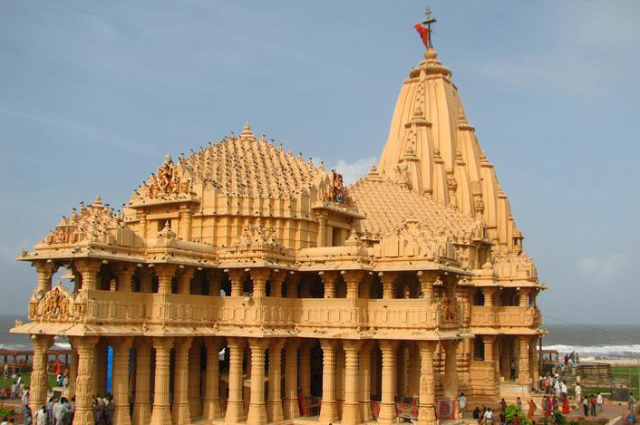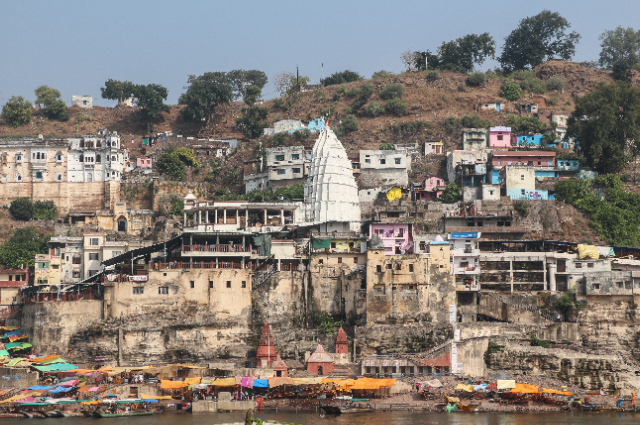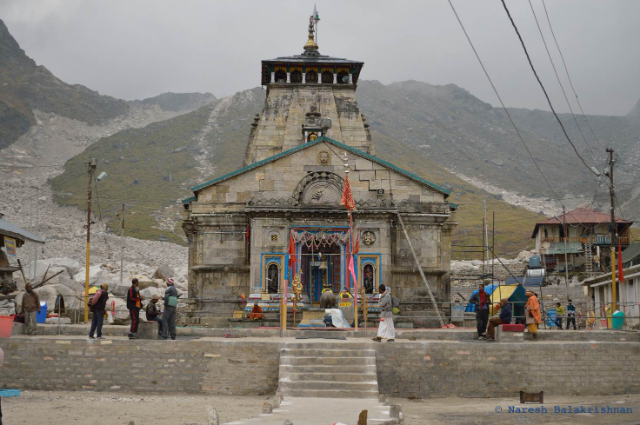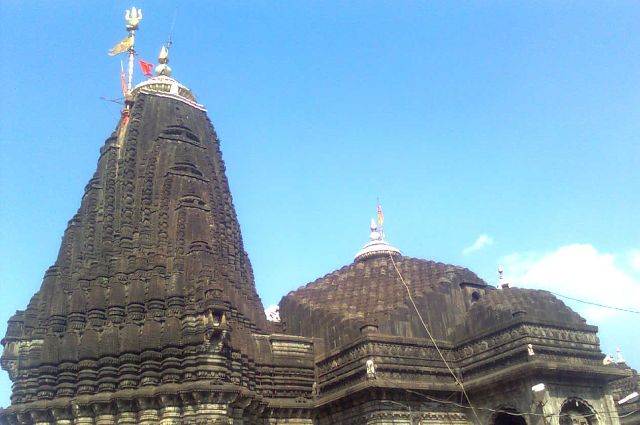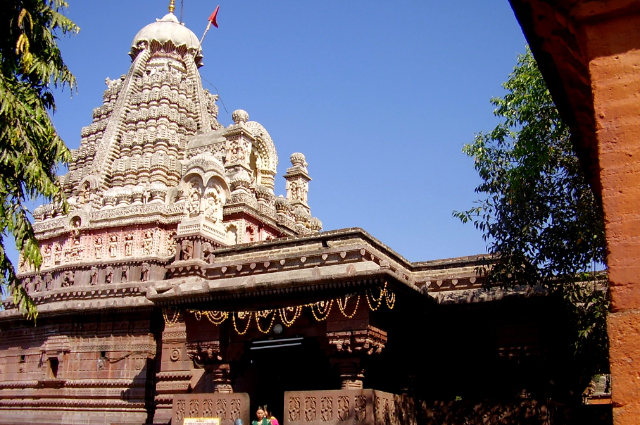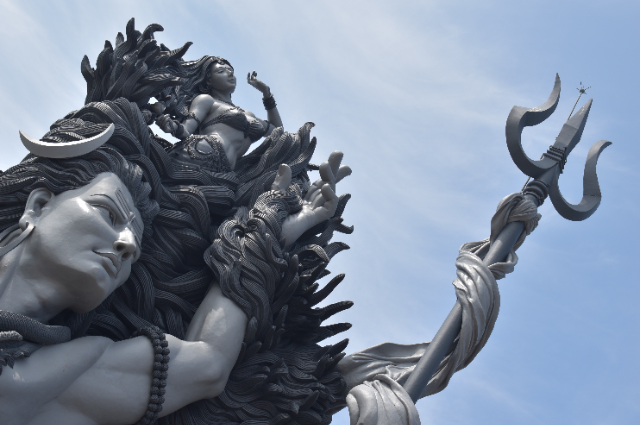
Dedicated To: This holy book is dedicated to the tourists of the world & the pilgrims at the present age as well as the upcoming generations and successors in the near future to enrich their religious knowledge & the amazing history of our ancient past.
Courtesy & References: This is a spontaneous attempt to present the destinations & the facts behind Are from Vayu Purana & Kasi Kanda of the Skanda Purana & the Padma Purana, Linga Purana, Shiva Purana, and Matsya Purana respectively.
The Destinations - Part One
Jyotirlingas are sacred shrines of Lord Shiva. Traditionally it is believed that Lord Shiva himself stays in these places. So they have a special place for the devotees.
There are twelve Jyotirlingas in India.
Jyotirlingas means a pillar of light & the column or pillar represents that it has no beginning nor end. Once Lord Brahma & Lord Vishnu had an argument about their supremacy. Then Lord Shiva appeared there as a pillar of light and asked them both to find the end and the source or origin. But neither Brahma nor Vishnu could do it. From then it is believed that the places where these columns of light fell are where the jyotirlingas are situated.
Here I have briefly described all the jyotirlingas and all these places which are well known as sacred pilgrimages.
Somnath Jyotirlinga
The Somnath Jyotirlinga is located in Prabhas Patan in Saurashtra, the western part of Gujarat, India, at the junction or sangam of the Saraswati, Hiranya, and Kapila rivers Known as Triveni Sangam. It is considered to be the first of jyotirlingas & the first place where Lord Shiva manifested himself.
It is believed that the temple was originally built by God Moon with gold in Satya Yuga, by Ravana in Treta Yuga with silver lastly by Lord Sri Krishna with sandalwood in Dwapar Yuga.
This temple was looted & demolished with many items by invaders named Mahumud Ghazni, Afzal Khan, Alauddin Khilji’s commander, Muzaffar Shah, Muzaffar Shah., Mahmud Begada, and later Aurangzeb.
Also, many Hindu Kings of ancient India reconstructed the temple such as Vikramaditya of Ujjaini, the Vallabhi Kings, Bhimdeva of Anhilawada, and Khangara the king of Junagadh are among the names.
The temple has been reconstructed about seventeen times. The modern structure was constructed by India’s former Deputy Prime Minister Sardar Bllav Bhai Patel between 1947 & 1951 in sandstone & was completed after his death. The word Somnath means God of the Moon who is none other than Lord Shiva.
Mallikarjun Jyotirlinga
Mallikarjuna Jyotirlinga is the second Jyotirlinga situated on a hilltop by the Krishna River in Andhra Pradesh. Several rulers contributed to the building and maintenance of the Mallikarjuna Swamy temple. However, the first one is the Shathavahanas empire builders in one AD. And subsequently, Iksvakus, Pallavas, Chalukyas &
Reddis who were also followers of the Mallikarjuna Swami contributed to the temple. The Vijayanagara Empire and Chatrapati Shivaji also improved the Shrine and temple building in 1667 AD.
The worship was disturbed here at the time of the Mughal reign. but resumed in the British period. However, only after independence, the temple got back into prominence.
Mahakaleshwar Jyotirlinga
This temple is situated in the historical and ancient city of Ujjain in Madhya Pradesh. It is located on the banks of the holy river Shipra. This temple was built in Marhata, Bhumija & Chalukya architectural techniques. The temple has five floors. One of which is underground. These are images of Lord Shiva’s consort, Goddess Parvati, Ganesha & Kartikeya, and his mount Nandi in the north, west, east & south respectively.
On the second floor above the Mhakalehwar linga is Omkareswara linga. On the third floor of this temple, there is an image of Nagchandreshwar with Lord Shiva and Mother Parvati seated on a ten-hooded snake & surrounded by other statues of gods. The temple has a tall spire with attractive and beautiful carvings.
This temple is mentioned in the Puranas which stated that Prajapita Bramha built the temple which is proof of ancient existence. It was built by Kumarsena in the sixth century AD the son of a former king Chand Pradyot of Ujjain.
Again the temple was reconstructed in the twelfth century AD by King Udayaditya and King Naravarman. Later the Maratha commander Ranoji Shinde under Peshwa Baji Rao renovated the temple in the eighteenth century AD.
Omkareswar Jyotirlinga
This temple is situated in Mandhata an island on the Narmada River in the Khandwa district of Madhya Pradesh. This temple has a large prayer hall with about sixty huge and elaborately carved stone pillars supporting it. This is a five-storied structure and each floor has various gods. Above the Omkarehwar linga is the Mahakaleshwar temple. Sidhnath, Gupteshwar & Dhajeshwar temples are on the third, fourth & fifth floors respectively. The tribal Bhil leaders ruled Omkareshwar under the rule of the Parmar rulers of Malwa. The period was from the tenth to the thirteenth century AD when many temples were built and renovated.
As per Hindu legend, Vindhya the god controlling the Vidhyachal mountain range was worshipping Lord Shiva to self regret the sins committed by himself. He created a geometrical shape and a Lingam made of sand & clay. Lord Shiva was pleased with his worship & believed to have appeared in two forms known as Omkareshwar & Amaleswara. As the mud mound appeared in the form of Om the island was named as Omkareswara. There is a shrine for Mother Parvati and Lord Ganapati in the temple.
Kedarnath Jyotirlinga
Kedarnath Jyotirlinga is situated at a height of three thousand and five hundred meters above sea level in Uttarakhand. This temple is the highest out of the twelve jyotirlingas in India. This temple is located at the head of the Mandakini and mythical Saraswati river in the Garhwal Himalayas.
The name Kedarnath means the Lord of the Field. It is derived from the Sanskrit word Kedara means “field” and natha means” Lord”.
This temple was built with huge stone slabs over a rectangular platform. There are inscriptions in Pali scripts on the steps. There are figures of various gods and scenes from Hindu mythology on the inner walls. A large statue of the Nandi Bull, Shiva’s mount stands as guard at the entrance.
One of the first references to Kedarnath is in the Skanda Purana which was written around the seventh & eighth century AD. The present structure is believed to have been constructed by Adi Sankaracharya about twelve hundred years before. It stands next to the site of a temple that is said to have been built by the Pandavas. This temple has been renovated many times over the centuries.
Bhimashankar Jyotirlinga
Bhimashankar Jyotirlinga temple is located on the banks of River Bhima. A marvelous black rock structure with a Nagara architectural pattern. The temple is surrounded by a wildlife sanctuary of a similar name to this jyotirlinga in Maharastra. The temple is believed to be built by Bhima the son of Kumbhakaran. A huge number of pilgrims visit the shrine around the year. There is a Kamala temple also an incarnation of Parvati situated nearby. This is one of the most popular Jyotirlingas in India.
It is believed that the ancient shrine was built around Sawambhu linga i.e. a linga that originated on its own. The linga is exactly at the center of the floor in the temple’s sanctum. There are intricate carvings of divine and human beings on the pillars and doorframes of the temple. There is also a shrine for Lord Shaneeshawara inside the temple. A statue of Lord Shiva's mount, Nandi can be found at the entrance of the temple as is common in Shiva temples.
Viswanath Jyotirlinga
Viswanath Jyotirlinga is situated in Varanasi, Uttar Pradesh, India on the bank of the river Ganges. Since it t was known as Kashi and that is the reason this temple is popularly known as Kashi Viswanath temple.
In Puranas, this temple is mentioned. This temple was demolished by Qutab -ud-din Aibak in 1194 AD & then by other invaders over the centuries including Mughal emperor Aurangazeb in 1669 who built a mosque on its site.
The temple was reconstructed by various rulers which include Mughal emperor Akbar, General Raja Man Singh, and his finance minister Raja Todar Mal. The present structure was built on an adjacent site by Maratha ruler Rani Ahilya Bai Holkar of Indore in 1777.
The Jyotirlinga is at the center of the sanctum on a silver altar. There are shrines to other gods such as Lord Vishnu, Vinayaka, Kabhairav, and Shaneeshwara. There is a well inside the temple which is called the Wisdom Well or Jana Vapi. It is believed that the linga was hidden here when the Mughals came to destroy the temple.
The spire of the temple was plated with gold donated by Maharaja Ranjit Singh in 1835. Since its three domes are gold plated the temple is known as the “Golden Temple of Varanasi”
Trimbakeshwar Jyotirlinga
Trimbakeshwar Jyotirlinga is situated at Trimbak which is near Nashik, Maharastra in India. Near Trimbak River Godavari originates. Three hills surround this temple Brahmgiri, Nilgiri, and Kalagiri.
The Shiva temple was constructed by the Prime Minister of the Maratha Empire Peshwa Balaji Bhaji Rao who was also known as Nana Saheb in the mid of eighteenth century.
The entire temple is built with black stone. The main feature of Trimbakeshwar Shiva temple is that the jyotirlinga has three faces representing the gods Shiva, Vishnu, and Brahma. They all exist within the hollow space in the Shivlinga. So the name Trimbakeshwara means three Lords & they all are covered by a jeweled crown that is believed to be the era of the Pandavas.
The images of Lord Rama, Krishna, Ganga, Parsuram, and Kedarnath are also there in this temple. The temple has a well called Amritavarshini. It also has a sacred pond which is believed to be the source of the River Godavari.
Vaidyanath Jyotirlinga
Vaidyanath Jyotirlinga is situated in Deoghar, Jharkhand, India. Here Deoghar means mome of Gods. Vaidyanathh Dham has been renowned since the rule of the last Gupta emperor. Aditya Sena Gupta in the eighth century AD. Mughal emperor Akbar’s brother-in-law dug a pond at Deoghar named Mansarovar. This temple appears to have maintained its importance even during Muslim rule in India.
Along the main temple of Baba Vaidyanath, there are also twenty-one other temples.
Some of the shrines found there are Parvati, Ganesha, Brahma, Kalabhairav, Brajranbali, Saraswati, Ram, Laxman, Janaki, Ganga, Kali, Annapurna & Laxmi Narayana. Mother Parvati's temple is tied to the Shiva temple with red sacred threads.
Here the main temple has a pyramidal tower with gold vessels set compactly. These were gifted by the Maharaja of Giddaur, Rja Puran Singh. There are also five knives in a trident shape named Punchsula as well as a lotus jewel with eight petals called Chandrakanta Mani. There is a huge Nandi & Lord Shiva’s mount in front of the Lord.
Nageshwar Jyotirlinga
The Nageswara Jyotirlinga is situated in Daarukavanam between the river Gomti & Dwarka on the coast of Saurashtra in Gujarat, India. It is believed that Adi Sankaracharya laid the foundations of his Western Math at Kalika Peetha.In this place.
There is a huge statue of Lord Shiva in a sitting position & a large garden with a pond is in this temple. The linga is made of Dwaraka shilaand has small chakras on it.It is in the shape of a three-face rudraksha & it faces south while the temple faces to the East direction.
Rameswaram Jyotirlinga
Rameshwaram Jyotirlinga temple is situated on the Rameshwaram island in Tamilnadu, India. The ancient shrine is said to have been housed inside a thatched hut till the 12th century, Parakrama Bahu of Sri Lanka was said to have begun the masonry work here. The rest of the temple was built by the Setupathy rulers of Ramanathapuram.
The present structure of the temple is believed to have been built in the 17th century AD. A Number of royal families from Travancore, Ramanathapuram, Mysore, and Pudukkotai have patronized the temple and added to its current beauty.
Grishneshwar Jyotirlinga
Grishneshwar Jyotirlinga is situated in Ellora near Daulatabad in Maharashtra, India. This temple is mentioned in Shiv Purana & Padma Purana. The site was destroyed by the Delhi Sultanate in the thirteenth to fourteenth century AD. The temple was reconstructed by the Maratha ruler Shivaji’s grandfather Maloju Bhisale of Verul in the sixteenth century AD.
The present structure was built by Queen Ahilyabai Holkar of Indore in the eighteenth century AD after the fall of the Mughal Empire. The temple is built of red rock and is composed of a five-tire spire. The ten avatars of Lord Vishnu are carved in redstone. There is a court hall built on twenty-four pillars on which the carvings of various legends and mythologies of Lord Shiva can be visible. The sanctum houses the east-facing linga. In the court hall the statue of Lord Shiva’s mount, Nandi the bull also found in the court hall.
Ghusmeshwar Jyotirlinga Temple Shiwad
An alternative opinion says that Ghusmeshwar Temple in Shiwad, Rajasthan has the twelfth Jyotirlinga.
It is told that. the twelfth Jyotirlinga in Shiwad is the abode of Lord Shankar its abode is nestled in the picturesque Devgiri hills in Shiwar, district Sawai Madhopur, state of Rajasthan, India around a hundred kilometers from Jaipur. It is three kilometers from Isarda railway station near to Kota-Jaipur rail route.
Shree Ghushmeswar Jyotirlinga is dedicated to Lord Shiva an ancient Shiva temple is located next to a small old fort. This is the ancient temple of Lord Shiva with a modern presentation of various Gods and goddesses under the old fort. It is also known as Dwadash Jyotirlinga of Lord Shiva.
On the basis of historical facts, it came to light that Mahmood Gajani sent his army commander Masood with an army to loot & damage the famous well-known temple in Vikram Samvat in 1081 AD. Maharaja Chader Sen Gaur along with his son Indrasen army chief Rewat & three thousand army men died in presenting the temple from enemies in battle in the memory of the queen and priestess there are memorials. Latter in 1179 AD the temple was rebuilt by King Shiv Veer Singh Chauhan. The king invited two well-known Brahmins from the great sage Vashistha's origin from Puskar for worship at the temple.
In 1358 AD en route to Ranthmbhor to fight Rana Hamir Khiliji sent an army unit under Malik Kafur to destroy the newly built temple. The army unit faced big devastation to the village and granaries. The army unit also began dismantling the temple but had to stop owing to night. In the dream that night Khilji saw a half-naked trident handling Kamandaldhari's exotic personality prepared to kill him. Then feared Khilji could not sleep the whole night. The next morning he revealed the dream. Then the pujari of the temple told him that the deity in the dream was none other than Lord Shiva himself who could turn the universe into ashes just by the fire of his third eye. Hearing this fear Khilji decided not to destroy the temple and proceeded to Ranthmbhor.
The Facts Behind - Part Two
Puranas are ancient devotional texts written by the great sage Veda Vyasa. It covers the importance of various deities i.e. Vinayaka, Kartikeya, Shiva & Parvati. In the eighteen Puranas, various devotional stories are also covered. All these stories are written in Sanskrit and in the course of time the stories were translated into many Indian languages.
The Puranas help us to know about the ancient history of various gods and goddesses, sages & saints. Some of the amazing stories written in the holy Shiva Purana are presented here.
Story Of Mother Parvati
After Dakshyayagna Mother Sati have taken the Parvati avatar. Her parents were the king of the mountain Himalayas Lord Himavan & mother Mainavati. Mother Parvati performed rigorous penance on Lord Shiva on the mountain Himalayas to marry him. Lord Shiva was pleased by Mother Parvati's devotion & finally, he agreed to marry her. Lord Himavan and Mother Mainavati had made the necessary arrangements for their marriage. During the marriage ceremony, Mother Mainavati prepared herself to welcome the guests, and when she saw Lord Shiva she was pleased with their presence.
But when she saw Lord Shiva who was supposed to be the son-in-law of Mainavati was surprised to see his strange presence. Lord Shiva’s head contains matted hair, his body was applied with sacred ash, his eyes look red & he was wearing tiger’s skin. Mother Mainavati was shocked to see the strange appearance of Lod Shiva and even she didn’t want the great Lord Shiva to become her son-in-law. After knowing about this sage Narada prayed to Lord Shiva and the great Lord Shiva had shown his true form in which he has worn costly garments & ornaments looking very attractive as well as handsome. The form is known as Chandrasekhar.& scented smell started to rise from his body.
Seeing his divine form Mother Mainavati realised her ignorance & sought an apology to her son-in-law Shiva. Lord Shiva smiled at her & said that he had appeared in a different form to her only to wash out the worldly illusions from her mind.
Story of Nala & Damayanti
Once there was a hunter with his wife at a cave in a mountain. And nearby that cave a small Shiva temple was there. Every day both of them used to worship the holy Shiva Lingam by adorning flower garlands and they used to perform holy milk both to the Shiva Lingam. One day a sage came to the place to the place to worship the Shiva Lingam in the temple.
On seeing the great sage the hunter & his wife invited him to their cave & also offered honey, fruits & milk as food items to him. At night time the hunter asked his wife and the sage to sleep inside the cave & he began to sleep outside of the cave to protect them from the wild animals. At midnight the when the hunter slightly closed his eyes a big tiger caught hold of him & broke into pieces ate his body & ran away from the place.
On the very next day morning when the hunter’s wife and the sage came out of the cave, they were shocked to see the body parts of the hunter consisting few of his bones and flesh. On seeing this the hunter’s wife committed suicide by self-immolating herself due to the pitiable condition of the couple the sage also died of a heart attack. But due to the grace of Lord Shiva, during their next birth, the hunter couple was rebirth as Nala & Damayanti, and the saint was taken birth as a swan and it has helped them to unite in their life.
The Story Of Lord Vishnu
Once when the gods suffered from demons they met Lord Vishnu in Paradise & sought his help to defeat the demons. Lord Vishnu began to visit the holy Kailash Mountain & there he performed worship of Lord Shiva offering him the holy flower Lotus. But after offering nine hundred and ninety-nine lotus flowers he found one flower was missing. Then without any hesitation, Lord Vishnu tried to remove one of his eyes itself considering it as a lotus flower.
Pleased by Lord Vishnu’s devotion Lord Shiva appeared before him & stopped the act and granted him the famous weapon Sudarshana Chakra which is known as Sri Vishnu Chakra. Lord Vishnu happily accepted the Chakra & with that divine Chakra he several demons & protected the gods.
The Story Behind Somnath Jyotirlinga
It is said that the moon god was married to the twenty-seven daughters of Daksha Prajapati. Although the moon god favoured Rohini over the rest. This caused the reason of anger in Dasha Prajapati and he insisted that the Moon should be impartial in his affections. But when the Moon didn't obey his wish Daksha Prajapati cursed him and made him lose his luster.
The result was without moonlight the world became dark. So all the gods requested Daksha Prajapati to retract his curse. But then it was just impossible to retract the curse by him. Then Saint Atri the father of the Moon prayed to Lord Shiva & he told him that the curse couldn’t be retracted although he blessed the moon god with the boon of immortality and that is the reason Lord Shiva is referred to as, Someshwar the Lord of Moon. It is said that the moon god bathed the Saraswati river to regain his luter which is the reason for the waxing and waning of the moon and the tides in this seashore location.
The Story Behind Mallikarjuna Jyotirlinga
Lord Shiva and his wife Parvati could not make up their minds as to which their sons Ganesha & Krtikeya should get married first. To determine who would be the first they set a contest between the two whoever would go around the world first would be the winner. Lord Kartikeya immediately set off on his mount, the peacock, Lord Ganesha on the other hand went around his parents claiming that they were the world to him. It is said that going around one’s parents is equivalent to going around the world. Hence he outwitted his brother and won the race. The pleased parents arranged the marriage of their son off to Siddhi & Riddhi. However, in some legends, Buddhi the intellect is also believed to be his wife. When Lord Kartikeyaa heard about this on his return he was very much upset and decided he would remain unmarried. And he left for Mount Krounch & started living there. His parents visited him there and hence there is a shrine for both there a linga for Lord Shiva and a Shakti Peetha for Parvati as well.
The Story Behind Mahakaleshwar Jyotirlinga
It is believed that King Chandrasena of Ujjain was a great devotee of Lord Shiva. Once while he was praying a young boy Shrikhar wished to pray along with him.Although he was not allowed to do the same&was sent away to the outskirts of the city. There he overheard a plot to attack Ujjain by enemy kings Ripudamana and Sighaditya with the help of a demon named Dushanan.
The boy then started praying to Lord Shiva to protect the city of Vridhi. A priest heard his prayers and he also prayed to the Lord Shiva to save the city. In the meantime the rival kings attacked Ujjain. When they were almost successful in conquering the city Lord Shiva appeared in his Mahakal form & saved them. Since that day at the behest of the devotees, Lord Shiva has lived in this famous Ujjain temple in the form of a Linga.
The Story Behind Omkareshwar Jyotirlinga
There are two stories related to Omkareshwar Jyotirlinga.One story says that two sons of the emperor Mandhata of the Ikshvaku dynasty performed severe austenites and pleased Lord Shiva because of which the mountain is named Mandhata Mountain and Lord Shiva manifested himself there as a Jyotirlinga.
The other story says that the Vindhya Parvat prayed to Lord Shiva performing severe penance to make the Vindhyas, his abode. Some say it was to become taller than Mount Meru. Lord Shiva was pleased with the penance and granted his wish by appearing as a jyotirlinga there. At the behest of the gods and sages, Lord Shiva split the Linga into two parts. One is at Omkareshwar and the other at Amareshwar or Mamleshwr. Hence the devotees visit both these temples when they visit Mandhata. It is said that Lord Shiva also allowed the Vindhyas to grow but only as long as he did not trouble the pilgrims. However, over time, Vindhya Parvat’s massiveness did cause problems for the devotees & so they sought sage Agaty’s help. The great sage ordered the mountain to stop growing until he came back which he never did and hence he solved the devotee's problem.
The Story Behind Kedarnath Jyotirlinga
The legend behind Kedarnath says that after the Mahabharata battle, the Pandavas performed a penance to purge their sins of killing their relatives in order to be able to do this. They searched high and low and ultimately saw Lord Shiva at the spot where the Jyotirlinga in Kedarnath is situated now.
It is said that Lord Shiva was not willing to forgive the Pandavas for their deceit and sins during the battle and hence hid himself from them. He disguised himself as a bull and disappeared into the ground.
The second Pandava Bhimsena tried to pull him out of the ground by tugging at his tail and hind legs. However, Lord Shiva dug himself deeper and only reappeared in parts in different places. The hump in Kedarnath, the arms in Tunganath, the naval & stomach in Madhyamaheshwar, the face in Rudranath, and the hair and head in Kalpeshwar.
The Pandavas built temples in these five places the Panch Kedars for worshipping Lord Shiva & this freed them from their sins. Lord Shiva further promised to stay in the sacred spot as a triangular Jyotirlinga. That is the reason Kedarnath is also famous and revered by devotees.
The Story Behind Bhimashankar JyotIrlinga
Different stories are there related to the Bhimashankar Jyotirlinga. The two of them are to be told here.
As per one story, a demon called Tripurasura performed penance in the Bhimashankar jungle to please Lord Shiva and ask him for the blessing of immortality. Lord Shiva was pleased with his devotion and granted him immortality on the condition that he would use his power to help the local people. Tripurasura agreed with him. However, over time he forgot his promise and began to harass both humans & the gods. When the gods prayed to Lord Shiva to do something to stop the ensuing chaos, Lord Shiva requested his wife Parvati. Both of them appeared as Ardhanari Nateshawara and killed Tripurasura after which peace prevailed. The other story says in the Dakini forests on the ranges of the Sahyadri Mountains there was a demon named Bhima with his mother Karkati. He was the son of Kumbhkarna who was the younger brother of King Ravana. When he came to know that Lord Vishnu killed his father in his human form as Rama he became furious. He vowed revenge and performed severe penance to please Lord Brahma. In return, Lord Brahma blessed him with immense strength which he used to terrorize the world. He imprisoned an ardent devotee of Lord Shiva Kamrupeshwar and demanded that he pray to him instead of Lord Shiva. When Kamrupeshwar refused to do so Bhims raised his sword to destroy Shivalinga. At that moment Lord Shiva appeared before him and reduced him to ashes. The place where Lord Shiva manifested himself is the spot where the Shivalinga is believed even today.
The Story Behind Vishweshwar Jyotirlinga
It is believed that Lord Shiva lived here but his mother-in-law was unhappy with his abode. To please his consort, Goddess Parvati, Lord Shiva requested the demon,
Nikumbha to make the place suitable for his family at Kashi. Parvati was so pleased with the residence that she offered food to everyone and that is the reason she is worshipped as Annapurna. Even Lord Shiva is believed to hold a begging bowl in front of her, seeking food.
The Story Behind Trimbakeshwar Jyotirlinga
In ancient times Saint Gautam lived on the Brahmagiri hills along with his wife, Ahalya. While there was famine everywhere else on the land, inside the saint’s ashram, there were abundant food grains. This was because the gods had blessed him because of his steadfast devotion and regular prayers. The other saints felt jealous of him and sent a cow into his fields.
When Saint Gautama tried to frighten the cow away from his fields, it died. For the sin of killing a cow, Gautama worshipped Lord Shiva to release the Ganga River and let her flow into his ashram to purify it. Pleased with his devotion, Lord Shiva released Ganga and told her to stay there. The Kushavarta or sacred pond that exists now is the source of the GodavariThe saint requested Lord Shiva also to make the site his abode, which the Lord did in the form of the jyotirlinga.
The Story Behind Baidyanath Jyotirlinga
It is said that demon king Ravana prayed to Lord Shiva seeking blessings that would make him omnipotent. As a sacrifice, he offered each of his ten heads one after another. This pleased Lord Shiva, who came down to earth and cured the injured Ravana. The act of curing made Lord Shiva equivalent to a doctor or baidya. Hence, the name Baidyanath.
Another story says that Ravana, one of the greatest devotees of Lord Shiva, requested him to make Lanka his home. The Lord could not agree to that but said that the Shiva Linga would be as good as his presence. He placed the condition that while transporting the linga, Ravana must not put it down anywhere. If he did, the place where he put it down would be the site of the linga. As Ravana was transporting it to Lanka, the gods feared the consequences of the linga at Ravana’s kingdom and requested Lord Varuna, lord of the waters, to break his journey. Varuna entered Ravana’s stomach, making the demon king want to relieve himself. He descended to the ground and handed the linga to a Brahmin (Lord Vishnu in disguise) and asked him to hold it.
As soon as Ravana went to relieve himself, Lord Vishnu placed the linga on the ground and disappeared. When Ravana returned, he realized that he had been tricked. The linga was fixed to the ground. He tried with all his might to displace it. However, he could not. So, he paid obeisance to it right there. This spot is believed to be Deoghar.
This temple doubles as a Shakti Peetha as well. When Lord Shiva’s first wife Sati immolated herself after her father Daksha’s Yagna, the grief-stricken Lord, roamed the world with her body. Lord Vishnu cut it up into 52 parts. It is said that her heart fell at Deoghar making it Shaktipeetha.
The Story Behind Nageshwar Jyotirlinga
Once there was a demon named Daruk who lived in the forest along with his wife.. Because of a blessing from Goddess Parvati, the demons had great powers which they abused to disturb festivities. They even captured and imprisoned a great devotee of Lord Shiva – a merchant named Supriya. Even in prison, Supriya continued his Shiva puja, wearing the holy rudraksha and chanting the Shiva mantra. His devotion touched the Lord and he appeared before him, slayed the demon & saved him. The place where the demon was killed is called Daarukavanam. It is said that the Lord placed the Shiva Linga (called Naganath) there to establish his residence there.
It is also believed that Lord Krishna himself used to worship Lord Shiva here; he is said to have performed the rudrabhishekam here.
The Story Behind Rameshwaram Jyotirlinga
Legend has it that Lord Rama worshipped Lord Shiva in this spot on his way back from Lanka – after defeating the demon king, Ravana. To atone for the sin of killing Ravana - a Brahmin and great Shiva devotee - Lord Rama offered prayers to Lord Shiva. Since there was no shrine for Shiva there, he sent Hanuman to Mount Kailash, Lord Shiva’s abode, to bring the linga.
However, Hanuman could not return before the auspicious time set to perform the puja, so Sita made a linga out of sand Ramalinga that Rama worshipped. When Hanuman returned, he was disappointed that Rama had not waited for his linga. To pacify him, Rama instructed devotees to worship the linga brought by Hanuman, which he called the Vishwalinga before the Ramalinga.
The Story Behind Grishneshwar Jyotirling
There are a couple of legends associated with this jyotirlinga.
One legend says that there was once a woman named Kusuma, who would worship Lord Shiva every day, immersing the Shiva Linga in a tank along with her prayers. Her husband’s first wife was jealous of her devotion and murdered her son.
Although Kusuma was grief-stricken, she kept up her faith and her devotion to the Lord. It is said that Lord Shiva was so pleased with her devotion that he brought her son back to life. Kusuma requested the Lord to stay on, which is why Lord Shiva manifested himself as a jyotirlinga here.
The Story Behind Ghushmeshwar Jyotirlinga
Shri Ghusmeshwar Jyotirlinga is situated at Shiwar village of district Sawai Madhopur, Rajasthan. Facts told in Puranas legend that a Brahmin by the name of Sudhrama lived in the distant past in the vicinity of Devgiri hills, whose wife Sudeha had not been blessed with offspring. She has, therefore, got her younger sister Ghushma married to her husband. Ghushma was a devotee of Lord Shiva whose devotion to Great Lord Mahadeva got her the birth of a son from her husband.
Sudeha her elder sister got jealous of Ghusma’s honour & happiness which ultimately resulted in the assassination of the newly married Ghusma’s son. who used to dispose of the earthen Shivalingas every day after worshipping. By the next morning, the bride found the bed with her dead son her mother-in-law.
On information, Ghushma did not lose her temper and she kept worshipping as usual. The very next day Lord Shiva appeared before Ghushma when she was immersing idols of Lord Shiva after worship. Pleased by her devotion Lord Shiva not only resurrected her son but also blessed her that he would always abide in this place as Ghushmeshwar after the name of Ghusma.
Another Local Legend Related To Ghushmeshwar At Shiwar. A long time before there was a milkman who had a few numbers of Blue bucks(Nilgai).During the daytime the blue bucks used to roam in the nearby jungles in search of grass etc. for their feeding. One day he observed that one cow is giving less quantity of milk than others. The milkman kept a very close watch on that cow.
Following the cow he observed that while they were roaming in the deep forest the cow used to go near to Shiva Linga and make a bath of milk of the Lord. Seeing this he found the reason for his loss. He became furious & threw his iron axe on the cow. Surprisingly nothing happened to the Blue Buck instead the axe rebounded on him and severely hurt him. He fell down senseless. Seeing this the wife of that milkman came and started weeping and praying to Lord Shiva and begged to save her husband. Being pleased by her devotion Lord Shiva appeared before her and blessed her & the milkman was alive again. The symbolic story is found in the form of a statue at the entrance of the Ghushmeshwar Jyotirling temple.

